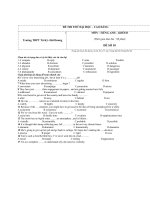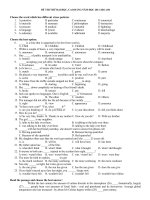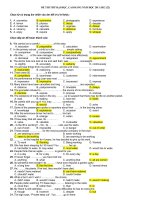Đề thi thử THPTQG môn Tiếng Anh số 7
Bạn đang xem bản rút gọn của tài liệu. Xem và tải ngay bản đầy đủ của tài liệu tại đây (63.06 KB, 4 trang )
BỘ GIÁO DỤC & ĐẠO TẠO
-----------------ĐỀ THI THỬ
(Đề thi có 04 trang)
ĐỀ THI TỐT NGHIỆP THPT QUỐC GIA
NĂM HỌC 2016 – 2017
Môn thi: TIẾNG ANH 12
Thời gian làm bài: 60 phút
( Không kể thời gian phát đề )
Mark the letter A, B, C, or D to indicate the word whose underlined part differs from the other three in
pronunciation in each of the following questions.
Question 1: A. worked
B. missed
C. realized
D. watched
Question 2: A. identify
B. pretty
C. daily
D. safety
Mark the letter A, B, C, or D to indicate the word that differs from the other three in the position of primary
stress in each of the following questions.
Question 3: A. verbal
B. polite
C. common
D. social
Question 4: A. environment
B. impossible
C. variety
D. valuable
Mark the letter A, B, C, or D to indicate the underlined part that needs correction in each of the following
questions.
Question 5: The land is going to be used for the construction of a technical institute and an university.
A
B
C
D
Question 6: The first important requirements for you to become a mountain climber are your strong passion and
A
B
C
you have good health.
D
Question 7: To attract someone's attention we can use either verbal and non- verbal forms of communication.
A
B
C
D
Mark the letter A, B, C, or D on your answer sheet to indicate the correct answer to each of the following
questions.
Question 8: ___________ TV for the last four hours? Turn it off and get some exercise.
A. Do you watch
B. Are you watching
C. Did you watch
D. Have you been watching
Question 9: The students don’t know how to do the exercise___________ by the teacher yesterday.
A. written
B. is writing
C. who written
D. which written
Question 10: The more you practise your English, ________ .
A. faster you will learn
B. the faster you will learn
C. the faster will you learn
D. you will learn faster
Question 11: They are having their house _______ by a construction company.
A. to paint
B. being painted
C. painted
D. painting
Question 12: During our stay in Venice, we bought a___________bottle.
A. glass lovely perfume
B. lovely glass perfume
C. lovely perfume glass
D. glass perfume lovely
Question 13Mrs. Carroll said she was going to _______an end to all the talking and foolingaround in our class.
A. take
B. bring
C. put
D. catch
Question 14: My uncle was _____ ill last summer; however, fortunately, he is now making a slow but steady recovery.
A. seriously
B. deeply
C. fatally
D. critically
Question 15: Not until the dedication of Yellowstone Park in the late nineteenth century _____ a national park.
A. the United States had
B. did the United States have
C. when the United States had
D. the United States having
Question 16: Although they played very well, they didn’t win the match because they lacked ___________
A. team work
B. team interest
C. team sport
D. team spirit
Question 17: While talking with native English speakers, we can take___________ a lot of new words and structures.
A. on
B. up
C. in
D. over
Question 18: In the past, women used to be __________dependent on their husbands or fathers.
A. economic
B. economical
C. economically
D. economy
Question 19: I accidentally ______ Mike when I was crossing a street downtown yesterday.
A. caught sight of
B. kept an eye on
C. paid attention to
D. lost touch with
Mark the letter A, B, C, or D on your answer sheet to indicate the word(s) CLOSEST in meaning to the
underlined word(s) in each of the following questions.
Question 20: In the 1980s, TV viewers began to hook up videocassette players to their TVs.
A. combine
B. stop
C. fasten
D.connect
Question 21: Thanks to better health care, there are more and more centenarians nowadays.
A. children whose parents can't afford their schooling
B. children who die at birth
C.people who live 100 years or more
D. people who suffer from fatal diseases
Mark the letter A, B, C, or D to indicate the word that is OPPOSITE in meaning to the underlined part in each of
the following questions.
Question 22: Hurricanes and tornadoes are too treacherous. Only a very foolish person would go out during that kind of
weather.
A. risk
B. endangered
C. delicious
D. safe
Question 23: I’m sorry I can’t come out this weekend – I’m up to my ears in work.
A. busy
B. bored
C. scared
D. free
Mark the letter A, B, C, or D to indicate the most suitable response to complete each of the following exchanges.
Question 24: John and Alice are talking about going to the movie.
~ John: "I was wondering if you’d like to go to a movie tonight."
~ Alice: "___________. What’s playing?"
A. Sure, I’d love to!
B. No, I don’t like it
C. Yes, I did
D. No, thanks
Question 25: Frank and Linda are talking about their math exam.
~ Frank: "Do you feel like studying tomorrow for our math exam?"
~ Linda: "_________ Come over around 10:00, after breakfast."
A. Yeah, sure
B. No, thanks
C. Sorry, I’m busy tomorrow
D. That sounds awful
Read the following passage and mark the letter A, B, C, or D on your answer sheet to indicate the correct word or
phrase that best fits each of the numbered blanks
Everyone wants to reduce pollution. But the pollution problem is as complicated as it is serious. It is complicated
(26)______ much pollution is caused by things that benefit people. For example, exhaust from automobiles causes a
large percentage of air pollution. But the automobile (27)______ transportation for millions of people. Factories
discharge much of the material that pollutes the air and water, but factories give employment to a large number of
people. Thus, to end or greatly reduce pollution immediately, people would have to (28)______ using many things that
benefit them. Most of the people do not want to do that, of course. But pollution can be (29)______ reduced in several
ways. Scientists and engineers can work to find ways to lessen the (30)______ of pollution that such things as
automobiles and factories cause. Governments can pass and enforce laws that require businesses and traffic to stop, or to
cut down on certain polluting activities.
Question 26: A. so
B. while
C. though
D. because
Question 27: A. takes
B. affords
C. carries
D. provides
Question 28: A. start
B. continue
C. stop
D. go on
Question 29: A. carefully
B. unexpectedly
C. gradually
D. little
Question 30: A. way
B. figure
C. number
D. amount
Mark the letter A, B, C, or D on your answer sheet to indicate the sentence that is closest in meaning to each of
the following questions.
Question 31: “No, it’s not true. I didn’t steal the money!” Jean said.
A. Jean refused to steal the money.
B. Jean did not intend to steal the money.
C. Jean admitted stealing the money.
D. Jean denied having stolen the money.
Question 32: Wealthy as they were, they were far from happy.
A. Although they were wealthy, they were not happy.
B. Even if they were wealthy, they were not unhappy.
C. They were as wealthy as they were happy.
D. They were not happy as they were wealthy.
Question 33: The woman was too weak to lift the suitcase.
A. The woman wasn’t able to lift the suitcase, so she was very weak.
B. The woman shouldn't have lifted the suitcase as she was weak.
C. The woman, though weak, could lift the suitcase.
D. So weak was the woman that she couldn't lift the suitcase.
Mark the letter A, B, C, or D on your answer sheet to indicate the sentence that best combines each pair of
sentences in the following questions.
Question 34: Crazianna is a big country. Unfortunately, it has never received respect from its neighbours.
A. Though Crazianna is a big country, it has never received respect from its neighbours.
B. Crazianna has never received respect from its neighbours because it is a big country.
C. It is Crazianna, a big country, that has never received respect from its neighbours.
D. Crazianna is such a big country that it has never received respect from its neighbours.
Question 35: He cannot lend me the book now. He has not finished reading it yet.
A. As long as he cannot finish reading the book, he will lend it to me.
B. Having finished reading the book, he cannot lend it to me.
C. He cannot lend me the book until he has finished reading it.
D. Not having finished reading the book, he will lend it to me.
Read the following passage and mark the letter A, B, C, or D on your answer sheet to indicate the correct answer
to each of the questions
ORCHIDS
Orchids are unique in having the most highly developed of all blossoms, in which the usual male and female
reproductive organs are fused in a single structure called the column. The column is designed so that a single pollination
will fertilize hundreds of thousands, and in some cases millions, of seeds, so microscopic and light they are easily
carried by the breeze. Surrounding the column are three sepals and three petals, sometimes easily recognizable as such,
often distorted into gorgeous, weird, but always functional shapes. The most noticeable of the petals is called the
labellum, or lip. It is often dramatically marked as an unmistakable landing strip to attract the specific insect the orchid
has chosen as its pollinator.
To lure their pollinators from afar, orchids use appropriately intriguing shapes, colors and scents. At least 50 different
aromatic compounds have been analyzed in the orchid family, each blended to attract one or at most a few species of
insects or birds. Some orchids even change their scents to interest different insects at different times.
Once the right insect has been attracted, some orchids present all sorts of one-way obstacle courses to make sure it does
not leave until pollen has been accurately placed or removed. By such ingenious adaptations to specific pollinators,
orchids have avoided the hazards of rampant crossbreeding in the wild, assuring the survival of species as discrete
identities. At the same time they have made themselves irresistible to collectors.
Question 36: What does the passage mainly discuss?
A. Birds
B. Insects
C. Flowers
D. Perfume
Question 37: The orchid is unique because of _______.
A. the habitat in which it lives
B. the structure of its blossom
C. the variety of products that can be made from it
D. the length of its life
Question 38: How many orchid seeds are typically pollinated at one time?
A. 200
B. 2,000
C. 20,000
D. 200,000
Question 39: Which of the following is a kind of petal?
A. The column
B. The sepal
C. The stem
D. The labellum
Question 40: The word "lure" in line 9 is closest in meaning to _______
A. attract
B. recognize
C. follow
D. help
Question 41: Which of the following is NOT mentioned as a means by which an orchid attracts insects?
A. size
B. Shape
C. Color
D. Perfume
Question 42: The word "their" in line 11 refers to_________
A. orchids
B. birds
C. insects
D. species
Question 43: Which of the following statements about orchids' scents does the passage support?
A. They are effective only when an insect is near the blossom.
B. Harmful insects are repelled by them.
C. They are difficult to tell apart.
D. They may change at different times.
Read the following passage and mark the letter A, B, C, or D on your answer sheet to indicate the correct answer
to each of the questions
COLORS AND EMOTIONS
Colors are one of the most exciting experiences in life. I love them, and they are just as important to me as
emotions are. Have you ever wondered how the two are so intimately related?
Color directly affects your emotions. Color both reflects the current state of your emotions, and is something
that you can use to improve or change your emotions. The color that you choose to wear either reflects your current state
of being, or reflects the color or emotion that you need.
The colors that you wear affect you much more than they affect the people around you. Of course they also
affect anyone who comes in contract with you, but you are the one saturated with the color all day! I even choose items
around me based on their color. In the morning, I choose my clothes based on the color or emotion that I need for the
day. So you can consciously use color to control the emotions that you are exposed to, which can help you to feel better.
Color, sound, and emotions are all vibrations. Emotions are literally energy in motion; they are meant to move
and flow. This is the reason that real feelings are the fastest way to get your energy in motion. Also, flowing energy is
exactly what creates healthy cells in your body. So, the fastest way to be healthy is to be open to your real feelings.
Alternately, the fastest way to create disease is to inhibit your emotions.
Question 44: What is the main idea of the passage?
A. Colorful clothes can change your mood
B. Emotions and colors are closely related to each other.
C. Colors can help you become healthy.
D. Colors are one of the most exciting.
Question 45: Which of the following can be affected by color?
A. Your need for thrills B. your friend's feelings
C. your appetite
D. your mood
Question 46: According to this passage, what creates disease?
A. wearing the color black
B. exposing yourself to bright colors
C. being open to your emotions
D. ignoring your emotions
Question 47: The term "they" in paragraph 3 refers to
A. emotions
B. people
C. colors
D. none of the above
Question 48: Why does the author mention that color and emotions are both vibrations?
A. to show how color can affect energy levels in the body.
B. Because they both affect how we feel.
C. to prove the relationship between emotions and color.
D. Because vibrations make you healthy.
Question 49: The phrase "saturated with" in paragraph 3 is closest in meaning to
A. bored with
B. in need of
C. covered with
D. lacking in
Question 50: What is the purpose of the passage?
A. to persuade the reader that colors can influence emotions and give a person more energy
B. to show that colors are important for a healthy life
C. to give an objective account of how colors affect emotions
D. to prove the relationship between color and emotion
THE END









